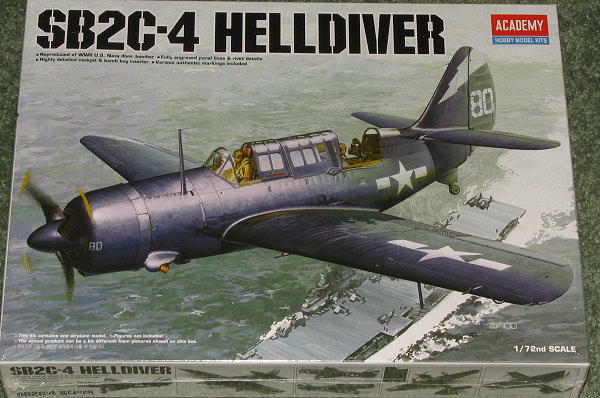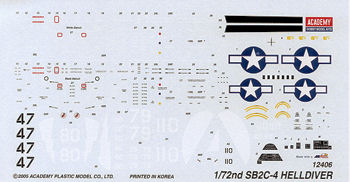
| KIT: | Academy 1/72 SB2C-4 Helldiver |
| KIT #: | 12406 |
| PRICE: | $25.00 MSRP |
| DECALS: | Four options |
| REVIEWER: | Scott Van Aken |
| NOTES: | New Mold |

| HISTORY |
The Helldiver was meant to replace the Douglas SBD Dauntless; it was a much larger aircraft able to operate from the latest aircraft carriers of the time and carry a considerable array of armament. The Model XB2C-1 prototype suffered teething problems connected to its R-2600 engine and 3-bladed propeller; further concerns included structural weaknesses, poor handling, directional instability and bad stall characteristics. The first prototype flew in December 1940. After the prototype crashed in February 1941, Curtiss was asked to rebuild it with revised structures and shapes. This second prototype version was also lost when in December 1941 the Helldiver pulled out of a dive and the starboard wing and tailplane failed catastrophically.
Large-scale production had already been ordered on 29 November 1940, but a large number of modifications were specified for the production model. The size of the fin and rudder was enlarged, fuel capacity was increased and self-sealing added and the fixed armament was doubled to four 0.50 in guns in the wings, compared with the prototype's two cowling guns. The SB2C-2 was built with larger fuel tanks, improving its range considerably.
The program suffered so many delays that the Grumman TBF Avenger entered service before the Helldiver, even though the Avenger had began its development two years later. Nevertheless, production tempo accelerated with production at Columbus, Ohio and two Canadian factories: Fairchild Aircraft Ltd. (Canada). which produced a total of 300, designated XSBF-l, SBF-l, SBF-3 and SBF-4E, while Canadian Car and Foundry built 894 examples designated SBW-l, SBW-3, SBW-4, SBW-4E and SBW-5, these models being respectively equivalent to their Curtiss-built counterparts. 7140 SB2C's were produced in the Second World War.
The large number (literally thousands) of modifications and changes on the production line meant that the Curtiss Helldiver did not enter combat until 11 November 1943 when they attacked the Japanese-held port of Rabaul in Papua New Guinea. Even though the Helldiver entered US Naval service, it still had such structural problems that the aircraft crews were forbidden to dive bomb in clean conditions (one of its main tasks). The SB2C-1 could deploy slats mechanically linked with undercarriage actuation extended from the outer third of the wing leading edge to aid lateral control at low speeds. The "Beast" was initially strongly disliked by aircrews because it was much bigger and heavier than the SBD it replaced. The litany of faults that the Helldiver bore included the fact that it was underpowered, had a shorter range than the SBD, had an unreliable electrical system and was often poorly manufactured. Opinions soon changed, however, and the SB2C would go on to sink more enemy shipping in the Pacific war than any other US or Allied aircraft.
900 aircraft were acquired by the USAAF under the designation A-25 and used in training and other miscellaneous duties. A total of 26 aircraft (out of 450 ordered) were delivered to the British Royal Navy's Fleet Air Arm, where they were known as the Curtiss Helldiver I. Postwar, surplus aircraft were sold to the navies of France, Italy, Greece, Portugal and Thailand.
| THE KIT |
 I
have to say that, along with many of you, I'm quite pleased to see a new mold
Helldiver. Prior to this we had a Matchbox and an Airfix version, both which
were nice at the time, but are no longer up to standards. This one from Academy
is.
I
have to say that, along with many of you, I'm quite pleased to see a new mold
Helldiver. Prior to this we had a Matchbox and an Airfix version, both which
were nice at the time, but are no longer up to standards. This one from Academy
is.
I'll let the inch-worms determine the overall accuracy of the kit as I'm not one who does that sort of thing. I can tell you that it certainly looks great in the box with nicely engraved panel lines and excellent detailing. Most of the parts have ejector pin marks on one side and while that isn't a problem with most bits, there are some (such as the wheels and roof of the bomb bay and inner bomb bay doors and gear doors) where removing them will not be easy. I also spotted a few very shallow sink areas on some thicker pieces.
A most complete cockpit is provided along with sidewall
details. The gunner's compartment is also nicely done. You can see detail in the
various instrument dials. A full bomb bay is also given and includes side by
side bombs with attached crutches. The kit also includes separate slats, and
while there is no mechanism, it is nice to have these. Dive brakes are molded in
the closed position, though I know that some of you would rather have them
separate so you can show them deployed. No additional parts are provided to have
the rear gunners hatch open so the guns have to stay stowed. Other small parts
are external tank racks, but no tanks. Rocket stubs are also molded on, but no
rockets provided. Clear bits are quite clear and it appears that the separate
canopy sections can be shown in the open position.

Instructions are well done and all the construction steps are in a 3-D presentation. I can take it or leave it as it does just as good a job as the earlier drawing style. Colors are in Gunze or FS 595 terms. There are markings for two planes. One is the box art plane in overall gloss sea blue from VB-85 aboard the USS Shangri-La in June 1945. A second plane from this unit is scheme 2. The third is in the tri-color scheme from VB-3 aboard the USS Yorktown in April 1945. Finally an Atlantic scheme plane from an unknown unit. One would hope that there will be an aftermarket sheet for this as Academy decals do not have a very positive reputation for working well. They look fine on the sheet and provide instrument decals if you wish to use them. The white may be a tad transparent, but again, one doesn't know until they are used.
| CONCLUSIONS |
Though this isn't a brand spanking new kit, it is the first time I've managed to get one and I have to say that I'm impressed by it. I'm a bit gun-shy regarding the markings and wonder why the weapons load is only bombs, but other than that, it should make into a really great model of the 'Beast'.
| REFERENCES |
Wikipedia
November 2006
Thanks to me and my wallet for providing this kit for you.
If you would like your product reviewed fairly and quickly by a site that has over 325,000 visitors a month, please contact me or see other details in the Note to Contributors.